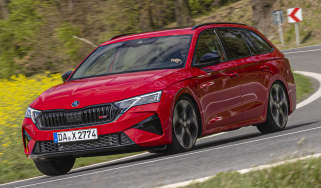Hillman Imp (1963-1976) icon review: small, slow but seriously good fun
We revisit the diminutive classic that majored on fun
The Hillman Imp could have been a real winner for the Rootes Group. No, scrub that – it should have been a winner. With a free-revving, all-alloy, overhead-cam powerplant, agile independent suspension all round, affordable pricing and a family-friendly design, the Hillman should have sold like hot cakes. But when this rear-engined wonder was launched 61 years ago, the Mini – on sale for four years by then – was already a runaway success in showrooms, on rally stages and on the race track, too.
The Mini had not only become a common sight on our roads, it had also ushered in a new era of space efficiency, usability, economy and manoeuvrability. The Imp was going to have its work cut out trying to compete, and – as things transpired, with it quickly building a reputation for fragility – its fate was sealed within months of it going on sale in 1963.
Using the development codenames Slug, then Apex, the car was built at a new factory in Linwood, Scotland. This was erected using a Government grant, in an area where there was huge unemployment. A new workforce was trained up, but there were frequent strikes due to abysmal working relations. The biggest issue, though, as was so often the case across the automotive industry back then, was that the Imp was launched before it was fully developed.
The first models used a troublesome pneumatic throttle, along with an automatic clutch and Teflon kingpin bushes that simply didn’t work. Yet those were just the start of the problems, because the water pumps were insufferably fragile, and the rest of the cooling system was marginal thanks to poor air flow.
The Imp’s reliability issues soon sullied its reputation, yet there were further reasons for its lack of success. Its rear-engined configuration was viewed with suspicion, while it initially came only with an 875cc capacity. On top of this, mechanics frequently misunderstood the hi-tech alloy motor. Overtightening led to all sorts of problems – yet another nail in the car’s coffin.
For Hillman, the rot had set in during development. Creating an all-new car was beyond the Rootes Group’s resources, so it sought outside help. By 1967, its Chrysler Corporation shareholder had bought the company outright. The Imp’s issues didn’t inspire heavy investment, and although it wasn’t the last Hillman (that was the Avenger), it did tip the brand – and the Rootes Group – on to the slippery slope to oblivion.
Back in 1965, a heavily revised model had picked up the baton, but the damage was done and buyers were wary. Such a shame: with its engaging dynamics and excellent practicality, the Imp was in fact one of the few cars that could rival the Mini, while there was also a wide choice of bodystyles. By 1969, the cost cutting had really set in, with a raft of changes that made the Imp even less desirable than it had been before. Quality was reduced on the interior trim, seat design, dashboard and many other bits, but despite this the Hillman limped on, eventually being put out to grass in 1976.
Enough of all the negativity, though, because while the Imp may have performed poorly in the showroom, as a classic it’s huge fun to drive. The car pictured is in Richard Usher’s Great British Car Journey collection in Derby and, as a 1972 example, it’s from an era when the reliability issues had been ironed out, but the build quality had taken a nosedive. As with most of Richard’s cars, this Imp is original rather than restored, so it’s cosmetically challenged here and there, but remains in rude mechanical health.
Driving a well sorted Imp provides a real buzz. The 875cc short-stroke four-cylinder engine is as rev-happy as they come, because it’s designed to run at up to 7,000rpm. With unassisted steering that’s light and sharp, you have a perfect recipe for driving fun. Throw in a precise gearchange and wonderfully compliant ride, and things get even better. As if this isn’t enough, the Imp’s kerb weight of little more than 700kg means the unservoed drum brakes front and rear don’t have to work too hard. Meanwhile, the rear weight bias isn’t apparent in normal driving – although it can bite if you press on.
Handling is kart-like thanks to a low centre of gravity, achieved by canting the lightweight engine over by 45 degrees. A mixture of swing axles at the front and semi-trailing arms at the rear ensures a smooth (if bouncy) ride, and 45mpg is easy to achieve even when the car is driven with zest. And doing that is very easy, because the low gearing gives fun acceleration, even if you do get through the four ratios quite quickly. With just 37bhp available, along with 66Nm of torque, the Imp can’t quite manage 80mph, and the sprint from zero to 60mph officially takes 21 seconds. It feels quicker than that once you’re rolling, though – even if this is clearly no sports car.
As an economy vehicle the Imp’s interior is spartan, with wipe-clean vinyl trim. The basic instrumentation – fuel, coolant-temperature and oil-pressure gauges, along with a speedometer – was par for the course at the time. But what’s really endearing is how fabulous the all-round visibility is, with those thin pillars meaning there are no blind spots whatsoever. Of course, the Imp wouldn’t fare too well in a smash, but it’s only when you drive a classic such as this, that you realise how safety has adversely, if necessarily, affected car design in more recent times.
The lack of beefed-up bodywork also means that despite the diminutive external dimensions, there’s reasonable cabin space, because it was so much easier to package cars back then. There were no airbags, door beams or crumple zones to accommodate, and the lack of a sporty roofline means there’s great headroom.
Not so impressive are the ergonomics and seat design. The ignition key is tucked away down near your feet, and with some switches unlabelled, you’re never quite sure what will happen when you activate them. Meanwhile, the flat, unsupportive chairs mean you slide around in corners, so after a long drive your back will be aching and your ears will be ringing from the engine noise. Remember, though, that when this car rolled off the production lines more than 50 years ago, Britain had not long entered the motorway age, amounting to a mere 1,000 miles worth across the UK.
Viewed as a classic for occasional use, the Imp makes a compelling proposition, but back in the day potential buyers weren’t convinced. Upon launch, Hillman had predicted it would sell 150,000 each year. Yet annual production peaked at just a third of this, and after 13 years only 440,000 examples had found owners.
This included a raft of variations such as the rebadged, slightly upmarket Singer Chamois, the Husky estate and the Commer Imp van. Other derivatives were the 52bhp Chamois Sport and Sunbeam Imp Sport, plus the limited-run 60bhp 998cc Rallye Imp and Rallye Chamois.
The most desirable models now are the rakish, 51bhp 875cc coupés that were launched in 1967: the Hillman Imp Californian, Singer Chamois Coupe and Sunbeam Stiletto. But by the early seventies the range was being pared back once more, and in ’76 the Imp bit the dust altogether. The brand is being kept alive now by a hugely enthusiastic owners’ club (theimpclub.co.uk), which also caters for an array of Imp-based rarities such as the Clan Crusader, Ginetta G15, Davrian Imp and Bond 875.
If you’re tempted, the best cars are passed on through the club, but at any one time there aren’t many for sale, because most owners invest money in theirs and then hang onto them for years. Whereas a couple of grand used to net a tidy Imp, you’ll need more like £5,000-£7,000 now, with really nice coupes closer to £10,000. Hardly small change – but drive a good example, and you’ll soon see why Hillman’s small family car deserved so much better than to live its life in the shadow of the Mini.
Interested in buying one?
Predictably, rust has destroyed most Imps. Rot can break out anywhere, but various high-quality new (repro) panels are available, including some made of plastic for greater durability.
The all-alloy engine is a lot stronger than its reputation suggests, although oil leaks are common. The key is to maintain anti-freeze levels; once they are weakened, corrosion sets in, the alloy breaks up, and the radiator gets blocked, so everything overheats. A stronger block on post-1966 engines is much less prone to heat deformation.
The four-speed box should be a joy. If changes aren’t slick, the nylon ball cup at the base of the stick needs to be replaced. It’s simple to do, and cheap.
Interior trim is scarce, although some used parts are available. Later, moulded seats aren’t easy to repair, but earlier cabins can be patched up quite easily. Replacement carpets are available, too.
Fancy another British classic? Now read our Rover SD1 icon review...



